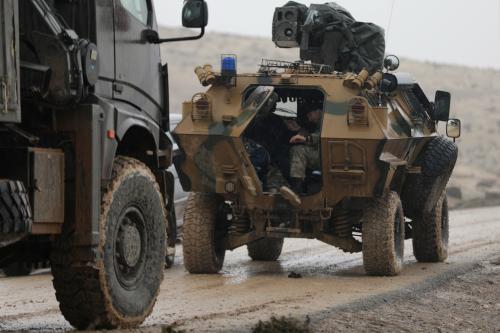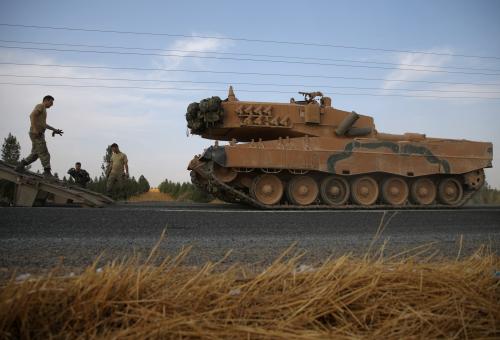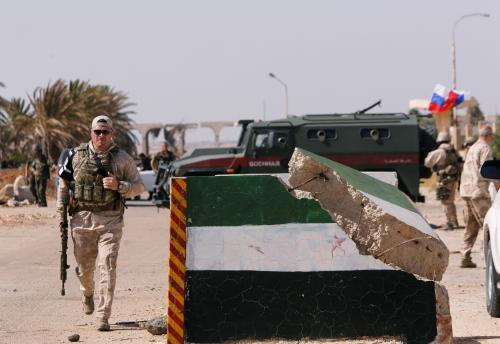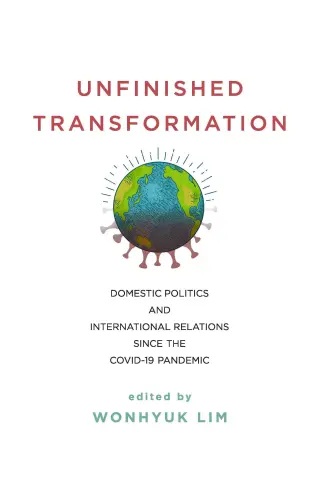Content from the Brookings Doha Center is now archived. In September 2021, after 14 years of impactful partnership, Brookings and the Brookings Doha Center announced that they were ending their affiliation. The Brookings Doha Center is now the Middle East Council on Global Affairs, a separate public policy institution based in Qatar.
It appears the discussion on a safe zone in northeastern Syria will have a major impact on the Turkish-U.S. relations and the approach of major powers toward Syria in the upcoming period, says Galip Dalay and E. Fuat Keyman. This article originally appeared on the German Marshall Fund website.
The United States’ decision to withdraw its troops from Syria has set off a scramble for northeastern Syria among regional and extra-regional powers. The tectonic plates have once again moved, power relations among actors have become subject to reconfiguration, and different visions for northeastern Syria have emerged. Turkey and its relationship with the United States are at the epicenter of these changes. Relations between them need to be reenergized in terms of strategy, tactics, and vision, yet divergence rather than convergence, and flexible alliances rather than a strategic partnership will continue to be the name of the game during 2019. Yet, at present, it appears the discussion on a safe zone in northeastern Syria will have a major impact on the Turkish-U.S. relations and the approach of major powers toward Syria in the upcoming period.
Actors and strategies
Russia, Iran, and the Assad regime contend that northeastern Syria should come under the control of the latter. Though rejecting any enhanced form of autonomy or federalism, Russia supports a limited form of cultural and administrative autonomy for the Kurds in Syria. Such a scenario anticipates the Kurds handing over control of the border to the government and the Syria Democratic Forces (SDF) fighters being integrated into the Syrian security forces. Yet it is not clear whether by integration Russia means these forces joining the Syrian army as individuals or as an entity. The Kurds favor the latter, whereas the regime desires the former. The Kurds appear to be open to any deal that will allow the SDF, or more accurately the People Protection Units (YPG) that forms the backbone of the SDF, to keep its autonomous organizational structure. In contrast, some in Washington with ties to the White House have entertained the idea of off-loading some of the United States’ roles and responsibilities in northeastern Syria on its Arab allies, particularly the members of the projected Middle East Strategic Alliance, a U.S.-initiated consortium of Gulf countries plus Egypt and Jordan. This group is driven by the goal of dual containment of Iran and Turkey. In a sense, it wants to limit the role of these two non-Arab countries in what they frame as Arab affairs. Yet this group is too feeble and incoherent to play any such a role.
The most discussed option has been a Turkish-U.S. bargain, yet Turkey’s strategic goal of rolling back and weakening the SDF’s gains and administrative structure are in contradiction to the goals set by the United States for its military withdrawal. These are continuing the fight against ISIS, protecting its allied Kurdish groups, and rolling back Iran’s influence in Syria.
Strategic incoherence and geopolitical incompatibility have been the defining qualities of Turkish and U.S. policies in Syria. Their visions, goals and threat perceptions have been diverging. They have mistrusted each other’s local alliances, seeing them through the lenses of terrorism. By emphasizing the YPG’s organic links with the Kurdistan Worker Party (PKK), which is on the terrorist list of Turkey, the EU, and the United States, Turkey accused Washington of allying itself with the offshoot of a designated terrorist organization. In contrast, Brett McGurk, the former U.S. envoy for the anti-ISIS coalition, recently depicted Turkey-allied Syrian opposition groups as being “marbled with extremists.” This line of thinking appears to be widely shared within the U.S. security and foreign policy establishment.
Though the Syrian conflict has aggravated Turkish-U.S. relations, it is not the sole cause of their downward trajectory. It is also a symptom of a deeper crisis in the relationship. Strategic decoupling and geopolitical incompatibility between the two countries have been real and ongoing for some time. The Cold War framework for their relations is not applicable anymore. At a time when the elite and institutional ownership of the relationship is fraying, the mistrust between Turkey and the United States is growing.
Safe zone through flexible alliances
This mistrust has been glaringly visible during the discussion around a safe zone in northeastern Syria. Whereas the personal relationship between President Recep Tayyip Erdogan and Donald Trump is good and improving, the institutional gap between the two countries remains wide. The positive news for Turkey is that with each change in Trump’s cabinet, the gap between the president and his administration is fast disappearing. The downside is that Trump operates according to his impulses and instincts rather than to well-thought-out policy visions. His Twitter diplomacy is subject to constant changes. This highlights the necessity of reinvigorating the institutional ties and partnership between Turkey and the United States within a rectified framework.
Nevertheless, as a result of the strategic decoupling between the two countries, which has been aggravated by the weakening of the traditional elite and institutional ownership of their relations, Turkey has pursued “flexible alliances” in recent years. Relations with Russia and Iran are cases in point. From cooperation within the framework of the Astana and Sochi processes on Syria to the purchase of Russian S-400 missiles, there has always been an invisible third party in any Russian-Turkish engagement, namely the United States, that defined their nature and quality. Likewise, Turkish-U.S. interactions on Syria similarly involve Russia as an invisible third party that conditions, constraints and even shapes them.
However, the Trump-initiated discussion with Turkey on a safe zone is a process rather than a deal. This process is likely to be impacted by what appears to be institutional resistance in the United States against a swift and unplanned withdrawal, the geopolitical calculations of Turkey’s partners in the Astana process (particularly Russia), and the Syrian Kurds’ ongoing talks with the Assad regime. It will first have to involve the clarification of the nature of a safe zone, including its goal and working mechanism, as well as of the political vision for nortnorteastern Syria. Such clarifications will reveal the nature of resistance to or acceptance of a safe zone.
There are divergent expectations between different actors. For the SDF, a safe zone should primarily serve as a buffer protecting it from Turkey. For Turkey, a safe zone is a means to fight the YPG and weaken the administrative structures in the areas held by the SDF. For the United States, it is a way to find a modus vivendi between Turkey and the Syrian Kurds and to ensure that Russia, Iran and the Assad regime will not fill the vacuum created as a result of its withdrawal.
Three trends
This process is likely to engender three trends. First, while seeking assurances from the United States and other international actors, the Syrian Kurds will also seek a deal with the Assad regime, which is likely to have its own reasons for negotiations now. When Trump first announced the U.S. withdrawal, the regime was in no hurry to negotiate with the Kurds, believing that over time they would become weakened and hence less demanding. Yet with a safe zone, the regime risks losing control of its border and of the hydrocarbon sources located in northeastern Syria for a long time. To avert this, Assad now has more motivation for a negotiation with the Kurds, something that is promoted by Russia. Moreover, though the current discussion between the United States and Turkey revolves around the Syrian Kurds, the question not only of which Kurds, but also which Arabs should participate in administrative and political structures in northeastern Syria is not easy to answer. The Arab allies of Turkey and the United States differ on this, with the latter being allied with the YPG and operating within the framework of the SDF.
Second, Russia is unlikely to oppose outright the idea of a safe zone to the point where it puts at risk its relations with Turkey. Instead, it is likely to situate this discussion within the larger framework of their relations and try to extract concessions from Turkey in other areas. At the same time, Russia will seek ways to dilute the content and depth of the safe zone discussion. Russia’s proposal during the recent Putin-Erdogan meeting points to such a policy. Moscow advanced the idea of reinvigorating the Adana agreement of 1998 between Turkey and Syria as a way to address Ankara’s security concerns.[1] Through this, Russia aims to achieve two goals: to re-establish relations between Turkey and the Assad regime and to dilute the content and depth of the projected safe zone, as the Adana agreement focuses on border security rather than creation of a safe zone inside Syria. Nevertheless, if the Turkish-U.S. engagement acquires the flavor of a process similar to the Astana one, Turkey will have to tread a fine line between both sides.
Third, discussions about a safe zone could become more time-consuming and internationalized. Apart from Turkey and the United States, actors such as France and Britain will highly likely become part of the conversation. This, in turn, can put further stress on Turkish-U.S. relations. The idea of a safe zone, which is pushed by the United States to overcome an impasse and enmity between its two allies, Turkey and the SDF, can antagonize both and wreak havoc on northeastern Syria if it is not well planned and implemented. So far, the biggest loophole of the proposed safe zone is the lack of a well-articulated political vision for the area, if not Syria in general.
Flexible alliances rather than strategic partnership
As the discussion about a safe zone illustrates, divergence rather than convergence prevails in Turkish-U.S. relations. Not only has the problem of trust arisen, which paved the way to the deepening of skepticism between two countries about their respective intentions, Turkey has also tended to prefer the establishment and implementation of flexible alliances with different actors in order to strengthen its position in the negotiations about the future of Syria and the region. This Turkish choice has become strategic insofar as it has begun to shape and frame the country’s proactive engagement with the region. From relations with Russia and Iran on Syria to relations with Iran and Iraq on the Kurdish referendum to relations with France, Germany and Russia on Syria, flexible alliances seem to have been working in the interest of Turkey by enlarging its capacity and influence in the region. This in return will have a formative impact on Turkey’s relations with the United States and the transatlantic alliance, the shape and meaning of which is increasingly in flux.
The Brookings Institution is committed to quality, independence, and impact.
We are supported by a diverse array of funders. In line with our values and policies, each Brookings publication represents the sole views of its author(s).







Commentary
Op-edTurkish-U.S. strategic decoupling through the prism of Syria
Thursday, February 21, 2019